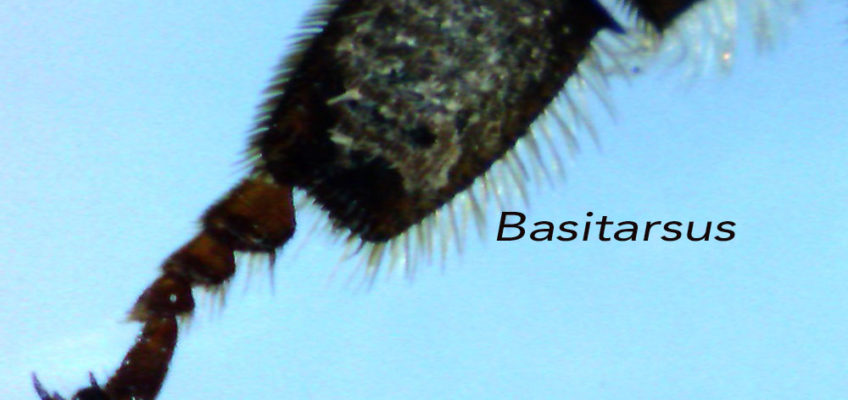The 27 bones that comprise our foot and ankle help us negotiate terrain of many kinds. We make changes in their position and articulation when we find ourselves walking on ice or skating in socks across a marble tile floor. We also pick up the pace when we are able to get a grip on a well-traveled trail through a forest, packed sand at the beach, or a concrete sidewalk. We can go up and down slopes as well as stand on our heels, toes, and the sides of our feet. At times, we even enhance the match between movement and activity by way of skis, thick-soled hiking boots, and shoes with cleats. Just as we have strategies for meeting the ground we walk on, so does the honey bee.
Subsegments Make a Segment
The five subsegments that make up the honey bee’s foot, the tarsus, enable the bee to maneuver in equally effective ways. They are called subsegments because they are unable to function apart from one another; all together, as the tarsus, they are a functional unit. Bee enthusiasts generally are familiar with the first of the foot’s subsegments, the one that is known as the basitarsus. It is home to the pollen combs on the two hindlegs of the worker bee. The fifth subsegment, the pretarsus, is of note here because it sports two tiny claws and a flexible pad, the arolium.
A Tendon Runs Through It
A tendon runs from the base of pretarsus to a muscle in the tibia and femur of the honey bee leg. Thus encompassing the length of the bee foot, the tendon leads the subsegments to “interlock” with one another when the bee contracts the muscle. This is because the subsegments telescope into one another, from one to the next, meeting up when the bee walks on comb, flower petals, and the sides of a beehive.
The claws and arolium enter directly into play when the honey bee takes a hike. Unable to change “shoes,” the honey bee engages these structures in different ways, depending on the surface. With the beginning of muscle contraction, the pretarsus moves around its hinge joint with the fourth subsegment of the tarsus. It flexes, such that the claws are first to make contact. With continuation of the movement, the arolium follows. We might compare this to our own step and how in walking we tend to first touch the ground with our heel and then roll onto the rest of our foot.
A Liquid Adds Surface Tension—and More
Although we can rappel down the sides of mountains and take advantage of ropes, harnesses, platforms, and even suction cups on tall buildings, the honey bee needs no special equipment in defying gravity. On a smooth surface, after the claws make contact with a surface, the arolium unfolds and then expands as a result of pressure from the bee’s contact with the ground. The pretarsus houses a gland that secretes a liquid, presumably from an opening at the base of the arolium, that creates surface tension and further helps the bee remain in place, whether horizontal or vertical. In contrast, when the surface has bumps and protrusions, the arolium does not unfold and thereby is protected from potential abrasion.
The liquid produced by the gland in the pretarsus contains a pheromone that remain behind when the bee leaves the surface. The scent alerts other bees to the presence and plays important roles in the colony, especially when it is the queen doing the walking. One cannot help but wonder what the substance secreted by the 250,000 sweat glands in our own feet might contain.
We know that the tarsus does not function alone. The other segments of the leg as well as the rest of the bee participate, of course! Still, whether through 27 bones or five subsegments, I expect we all agree that the ability to touch feet to the ground, smooth or rough, is a lovely thing.

